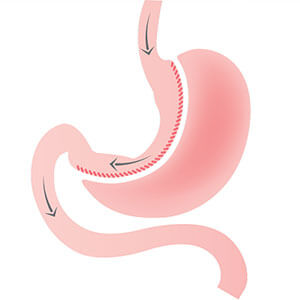
Surgery Duration
60-90
Minutes

Anaesthesia
General Anaesthesia

Hospital Stay
4 Nights

Total Stay in Turkey
4 Nights
Sutures will be absorbed
We’ll get back to you within one business day (via e-mail & WhatsApp)
A sleeve gastrectomy is a surgical weight-loss procedure in which the stomach is remodelled into a long tube about one-quarter of its original size. This procedure is typically performed laparoscopically, which involves inserting small instruments through multiple small incisions in the upper abdomen. During sleeve gastrectomy surgery in Turkey, almost 80% of the stomach is removed, leaving a tube-shaped stomach about the size and shape of a banana. Due to its restricted size fewer calories are absorbed through the stomach.
If you have been looking for a solution to help with your weight loss goals, at Badge Clinic we can offer a sleeve gastrectomy in Turkey for those eligible for this. To learn more about this life-changing procedure and book your free consultation, please complete our online form or email us at [email protected].


With sleeve gastrectomy surgery in Turkey, you’ll need to consider that this procedure irreversibly reduces the size of the stomach. By limiting the size of the stomach, this restricts the amount of food you can consume. This surgery can prove to be life-changing, however, it should only be considered for those who have already attempted other methods of weight loss first through diet and exercise. Successful surgery will drastically reduce your stomach size so that you will feel fuller much faster, which will reduce your calorie intake.
Sleeve gastrectomy also prompts hormonal changes which assist with weight loss. These hormonal changes also help relieve conditions associated with being overweight, such as heart disease or high blood pressure. This procedure is one of a few options for those struggling with obesity that will be assessed during a consultation. A gastric balloon Turkey surgery may be an alternative option, as well as a gastric bypass Turkey procedure which reroutes the digestive system.
The sleeve gastrectomy cost is one of the advantages of having this type of cosmetic surgery in Turkey when compared to having the same surgery elsewhere in the world. Here at Badge Clinic, we can offer affordable treatment options performed by renowned cosmetic surgeons, helping to keep costs lower whilst never compromising on patient care and safety. Turkey is well-known for attracting medical tourists from all over the globe, thanks to a lower cost of living and treatment subsidised by the government. This ensures you can undergo body aesthetic treatment whilst having a budget, with our team working with you on the perfect package to make the most of your trip.
During a consultation, we will discuss the costs of sleeve gastrectomy Turkey surgery that is personalised to your weight loss goals. We can even arrange for other procedures to be included, such as postbariatric surgery that will help to tighten the loose skin leftover from your procedure. Not only will the cost cover your treatments, but also your comfort, as you’ll stay in a 5-star hotel throughout your trip as well as benefit from VIP transfers between the hotel, airport and hospital facilities.




If you are struggling with obesity and have tried various weight loss methods without success, it may be time to consider a sleeve gastrectomy in Turkey. This procedure is recommended for individuals with a body mass index (BMI) of 40 or higher, or a BMI of 30-35 or higher with obesity-related health issues such as diabetes, high blood pressure, or sleep apnea. The procedure can also be appropriate for patients whose BMI is too high for other bariatric procedures.
Sleeve gastrectomy surgery can help you achieve significant and sustainable weight loss by restricting the amount of food you can consume and reducing hunger hormones. It can also lead to improvements in obesity-related health conditions too. Our experienced and skilled medical team at Badge Clinic is dedicated to providing safe and effective sleeve gastrectomy Turkey procedures, ensuring personalised care and long-term support to help you achieve your weight loss goals.
If we can help improve your overall health and quality of life, then please contact us today. We look forward to your enquiry and arranging a free consultation.
Gastric sleeve surgery typically takes around 60 – 90 minutes to complete and is performed under general anaesthesia. You may need to stay in the hospital for two to three days following the procedure, followed by a stay in your hotel accommodation before returning home.
The results from sleeve gastrectomy surgery vary from patient to patient but most can expect to lose 1 to 1 ½ kilograms per week until the normal weight range is reached. The success of your surgery depends on whether you adhere to your surgeon’s dietary and lifestyle recommendations. Your surgeon can discuss with you the results you should expect to see during your consultation.
No, some patients experience discomfort around the keyhole incisions for a few days after surgery. Occasionally patients experience shoulder tip discomfort which is related to diaphragm irritation. About 5% of people experience nausea after the general anaesthetic.
Gastric sleeve surgery is a relatively new procedure, and it is gaining rapid popularity worldwide. In the late 1980s and 1990s, surgeons started to do sleeve gastrectomy surgery as part of the duodenal switch operation. Over the years, surgeons noticed that a gastric sleeve caused significant weight loss. In the late 2000s and early 2010s, this procedure became increasingly popular. Large datasets, with more than 5 years of follow-up after the surgery, showed sustained weight loss.
With dramatic weight loss, there is often the unintended consequence of excess sagging skin. Post-bariatric surgery is a procedure that deals with excess skin and aims to tighten the body contours to a more natural and youthful shape. It can remove or tighten loose skin around the arms, neck, abdomen, and thighs.
The procedure is a combination of various procedures, such as the thigh lift, neck lift, arm lift, and tummy tuck, which are all designed to remove excess skin. In many cases, multiple sessions may be necessary, depending on the amount of excess skin to be removed. The sleeve gastrectomy costs, and any other procedure recommendations, will be discussed with you during your consultation.